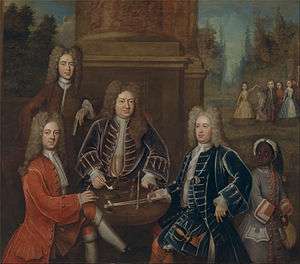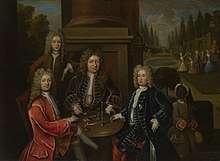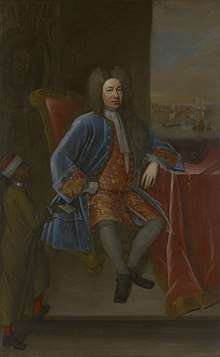Elihu Yale seated at table with the Second Duke of Devonshire and Lord James Cavendish
Elihu Yale seated at table with the Second Duke of Devonshire and Lord James Cavendish is a group portrait of Elihu Yale with William Cavendish and his brother James in England. It is currently in the collection of the Yale Center for British Art.
| Elihu Yale; William Cavendish, the second Duke of Devonshire; Lord James Cavendish; Mr. Tunstal; and an Enslaved Servant | |
|---|---|
 | |
| Artist | Anonymous |
| Year | c. 1708 |
| Medium | oil paint, canvas |
| Dimensions | 201.3 cm (79.3 in) × 235.6 cm (92.8 in) |
| Location | Yale Center for British Art |
| Accession No. | B1970.1 |
This is the larger of two versions at Yale, both presumably commissioned on the occasion of Yale's daughter Anne's betrothal to Lord James Cavendish. The larger version was acquired as a gift in 1970 by Andrew Cavendish, 11th Duke of Devonshire, from the collection at Chatsworth House, having come down through family inheritance. The smaller version on copper was acquired by the Yale University Art Gallery in 1954 from Mrs. Anna R. Butler, a donor from Bedford, NY who also founded the Arthur W. Butler Memorial Sanctuary in Mount Kisco. It was possibly commissioned by Yale himself. The larger version was the subject of a commentary on the history of slavery in cultural images by Jonathan Holloway.[1] It was also the subject of a commentary on the history of the Empire in India by Romita Ray.[2] She points out that it is Yale himself looking out of the painting at the viewer, dressed as if he was also of the same class as the Duke of Devonshire on his left. He is recognizable from his diamond ring, which is one of the many expensive objects he brought back from India.
.jpg)
The artist Titus Kaphar made an artwork called “Twisted Tropes”, highlighting the portrait of the black pageboy, but omitting his dog collar, in 2016.[3]
 Smaller version on copper
Smaller version on copper Elihu Yale with his Servant, by James Worsdale
Elihu Yale with his Servant, by James Worsdale.jpg) Anne herself is probably among the children playing in the upper right
Anne herself is probably among the children playing in the upper right_-_Google_Art_Project.jpg) Lady Anne Cavendish, by Jonathan Richardson the Elder, c. 1725
Lady Anne Cavendish, by Jonathan Richardson the Elder, c. 1725
References
- Commentary by Jonathan Holloway on Yale Center for British Art's website
- Commentary by Romita Ray on Yale Center for British Art's website
- tweet with image by Kaphar by Kaphar Studio
- Yale Center for British Art version
- Yale University Art Gallery version
- Vietor, Alexander O, "An Elihu Yale Conversation Piece" The Yale University Library Gazette 35, no. 4 (1961): 158-60